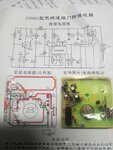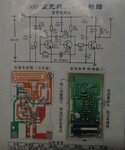tony_lth
Advanced Member level 5

Hi, Gurus,
I want to spend some time with my son together, so we decided to make a door ring.
We bought a raw PCB and mated RLC from a shop in Taobao.
Unfortunately, after we soldered all the components on the PCB, the door ring can't work.
Attachments are TX, RX, and one ppt for soldering the components respectively.
Who can help?
- - - Updated - - -
And I found some:
1. When I pressed the TX button, the tx part green LED is on, but the RX can't alarm, so I guess TX is OK , RX isn't.
2. When I used multimeter D1 4148 (between U1 CD4069 pin9 and pin10), forward then backward, then the RX alarm ring even without TX on.
Forward is multimeter red on D1 4148 anode, and black on cathode.
Backward is multimeter black on D1 4148 anode, and red on cathode.
I want to spend some time with my son together, so we decided to make a door ring.
We bought a raw PCB and mated RLC from a shop in Taobao.
Unfortunately, after we soldered all the components on the PCB, the door ring can't work.
Attachments are TX, RX, and one ppt for soldering the components respectively.
Who can help?
- - - Updated - - -
And I found some:
1. When I pressed the TX button, the tx part green LED is on, but the RX can't alarm, so I guess TX is OK , RX isn't.
2. When I used multimeter D1 4148 (between U1 CD4069 pin9 and pin10), forward then backward, then the RX alarm ring even without TX on.
Forward is multimeter red on D1 4148 anode, and black on cathode.
Backward is multimeter black on D1 4148 anode, and red on cathode.





